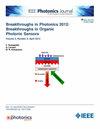基于液晶ris接收机的可见光通信与定位集成系统的设计与优化
IF 2.4
4区 工程技术
Q3 ENGINEERING, ELECTRICAL & ELECTRONIC
引用次数: 0
摘要
可见光通信(VLC)正在成为下一代无线网络的关键技术,利用丰富的免授权频谱以最小的能量开销实现超高数据速率。提出了一种基于液晶可重构智能表面(LC-RISs)的新型集成VLC和定位(VLCL)系统的设计与优化。所提出的系统架构通过在电场下动态调节LC-RIS的折射率来精确控制光的传播和聚焦,从而促进室内环境中的同时通信、定位和照明。我们解决了两个核心优化挑战:和速率最大化和能效最大化,这两个问题都被表述为约束优化问题。和率问题是凸的,可以用标准优化技术求解,而能效问题是非凸的,需要通过分式规划开发低复杂度的解决方案。仿真结果证实了LC-RIS在显着提高求和速率和能源效率方面的有效性,特别是在用户数量和接入点配置密集的情况下,从而证明了LC-RIS在大幅度提高VLCL系统性能方面的潜力。本文章由计算机程序翻译,如有差异,请以英文原文为准。
Design and Optimization of an Integrated Visible Light Communication and Localization System Using Liquid Crystal Based-RIS Receivers
Visible Light Communication (VLC) is emerging as a pivotal technology in next-generation wireless networks, leveraging the abundant unlicensed spectrum to achieve ultra-high data rates with minimal energy overhead. This paper presents the design and optimization of a novel integrated VLC and localization (VLCL) system enhanced by liquid crystal-based reconfigurable intelligent surfaces (LC-RISs). The proposed system architecture facilitates simultaneous communication, localization, and illumination within indoor environments by dynamically adjusting the refractive index of the LC-RIS under an electric field to precisely control light propagation and focus. We address two core optimization challenges: sum rate maximization and energy efficiency maximization, both of which are formulated as constrained optimization problems. While the sum rate problem is convex and solvable using standard optimization techniques, the energy efficiency problem is non-convex, necessitating the development of a low-complexity solution via fractional programming. Simulation results substantiate the efficacy of the LC-RIS in significantly enhancing both sum rate and energy efficiency, particularly in scenarios with dense number of users and access point configurations, thereby demonstrating the LC-RIS's potential to substantially improve the performance of VLCL systems.
求助全文
通过发布文献求助,成功后即可免费获取论文全文。
去求助
来源期刊

IEEE Photonics Journal
ENGINEERING, ELECTRICAL & ELECTRONIC-OPTICS
CiteScore
4.50
自引率
8.30%
发文量
489
审稿时长
1.4 months
期刊介绍:
Breakthroughs in the generation of light and in its control and utilization have given rise to the field of Photonics, a rapidly expanding area of science and technology with major technological and economic impact. Photonics integrates quantum electronics and optics to accelerate progress in the generation of novel photon sources and in their utilization in emerging applications at the micro and nano scales spanning from the far-infrared/THz to the x-ray region of the electromagnetic spectrum. IEEE Photonics Journal is an online-only journal dedicated to the rapid disclosure of top-quality peer-reviewed research at the forefront of all areas of photonics. Contributions addressing issues ranging from fundamental understanding to emerging technologies and applications are within the scope of the Journal. The Journal includes topics in: Photon sources from far infrared to X-rays, Photonics materials and engineered photonic structures, Integrated optics and optoelectronic, Ultrafast, attosecond, high field and short wavelength photonics, Biophotonics, including DNA photonics, Nanophotonics, Magnetophotonics, Fundamentals of light propagation and interaction; nonlinear effects, Optical data storage, Fiber optics and optical communications devices, systems, and technologies, Micro Opto Electro Mechanical Systems (MOEMS), Microwave photonics, Optical Sensors.
 求助内容:
求助内容: 应助结果提醒方式:
应助结果提醒方式:


